|
Size: 5898
Comment:
|
Size: 8937
Comment:
|
| Deletions are marked like this. | Additions are marked like this. |
| Line 11: | Line 11: |
| The workshop will start wednesday 04 morning and ends saturday 07 after lunch. It will take place at [[http://www.pmc.gob.mx/|Punto Mexico Conectado @ Oaxaca]] in [[http://www.openstreetmap.org/way/30435874#map=18/17.06483/-96.73348|calzada Madero numero 101]]. | The workshop was started on wednesday 04 morning and ended on saturday 07. It took place at [[http://www.pmc.gob.mx/|Punto Mexico Conectado @ Oaxaca]] in [[https://www.google.com.mx/maps/place/Punto+M%C3%A9xico+Conectado+Oaxaca/@17.0630565,-96.7325754,19z/data=!4m2!3m1!1s0x85c722148d9070eb:0x431c6d96d211d5b5|calzada Madero numero 101]]. |
| Line 13: | Line 13: |
| == Previsional schedule == | == Schedule == |
| Line 16: | Line 16: |
| ||<#FFFFAA> morning ||<#AFEFEF:> Participant presentation<<BR>>and<<BR>>Sage introduction || ? || ? || ? || ||<#FFFFAA> 13:00 - 14:30 || lunch break || lunch break || lunch break || lunch break || ||<#FFFFAA> afternoon || ? || ? || ? || FREE || |
||<#FFFFAA> 09:00 - 10:00 || registro y instalación || coding sprint || coding sprint || ? || ||<#FFFFAA> 10:00 - 11:00 || presentación de Sage || coding sprint || coding sprint || ? || ||<#F8F8FF> 11:00 - 11:30 ||<#F8F8FF> té y café ||<#F8F8FF> coffe break ||<#F8F8FF> coffe break ||<#F8F8FF> coffe break || ||<#FFFFAA> 11:30 - 13:00 || actividades practicas || coding sprint || sharing code howto || status report || ||<#CCCCFF> 13:00 - 14:30 ||<#CCCCFF> lunch break ||<#CCCCFF> lunch break ||<#CCCCFF> lunch break ||<#CCCCFF> lunch break || ||<#FFFFAA> 14:30 - 15:30 || presentation / discussion || coding sprint || coding sprint || FREE || ||<#FFFFAA> 15:30 - 17:00 || tutorial: symbolic vs numeric || coding sprint || coding sprint || FREE || ||<#F8F8FF> 17:00 - 17:30 ||<#F8F8FF> coffe break ||<#F8F8FF> coffe break ||<#F8F8FF> coffe break || FREE || ||<#FFFFAA> 17:30 - 18:00 || Pat Hooper's demo || Vincent's demo || Charles's demo || FREE || ||<#FFFFAA> 18:00 - 19:00 || coding spring || status report || coding sprint || FREE || |
| Line 22: | Line 29: |
| * (tutorial / presentation) Pat Hooper: [[https://github.com/videlec/sage-flatsurf|Flatsurf]] | * Presentación de Sage, (jupyter notebook [[attachment:Sage presentation.ipynb]]) |
| Line 24: | Line 31: |
| * (tutorial / presentation) Vincent Delecroix: [[http://www.labri.fr/perso/vdelecro/flatsurf.html|the flatsurf package]] (warning: distinct from the above!) | During the elaboration of the talk it appeared that many things differ between the jupyter and Sage notebook. It was reported on the mailing list [[https://groups.google.com/forum/#!topic/sage-devel/OO64qyj65oo|sage-devel]]. Some of the problem are already fixed (see e.g. [[http://trac.sagemath.org/ticket/20562|#20562]])! |
| Line 26: | Line 33: |
| * (tutorial) numerical computations with numpy and scipy within Sage ([[https://www.scipy.org/]]) | * '''symbolic vs numerics in Sage''' (tutorial, wednesday 15:30 - 17:00, Vincent Delecroix) There are many ways to deal with numbers within Sage (algebraic numbers, floating points, intervals, ...). We will present and illustrate pros and cons of all of them on some concrete problems: root finding, integration, solving ordinary differential equations. [[attachment:symbolic_vs_numeric.rst]] |
| Line 28: | Line 36: |
| * (tutorial) development howtos: [[https://en.wikipedia.org/wiki/Git_%28software%29|git]], the [[http://trac.sagemath.org/|Sage trac server]], mailing lists ([[https://groups.google.com/forum/#!forum/sage-devel|sage-devel]], [[https://groups.google.com/forum/#!forum/sage-support|sage-support]], [[http://pari.math.u-bordeaux.fr/lists-index.html|pari-users]], etc) and forums ([[http://ask.sagemath.org/|ask sagemath]]). | * [[https://github.com/videlec/sage-flatsurf|Flatsurf]] Pat's demo: PAT'S WORKSHEET TO COME |
| Line 30: | Line 38: |
| * ? (tutorial) number types in Sage: integers, rationals, number fields, symbolic, floating point, intervals, balls | * [[http://www.labri.fr/perso/vdelecro/flatsurf.html|the flatsurf package]] (demo, thursday 17:30 - 18:00, Vincent Delecroix) |
| Line 32: | Line 40: |
| * ? (tutorial) SL2Z and triangle group code in Sage * ? (tutorial) graphs and digraphs in Sage ([[http://doc.sagemath.org/html/en/reference/graphs/index.html|Sage graph stuff]] and possibly [[http://www.tcs.hut.fi/Software/bliss/|bliss software]], [[http://pallini.di.uniroma1.it/|nauty and Traces]], [[http://igraph.org/redirect.html|igraph]], ...) |
* '''computing Lyapunov exponents of the Teichmueller flow''' (demo, friday, 17:30 - 18:00, Charles Fougeron): CHARLES WORKHSEET TO COME |
| Line 38: | Line 44: |
| * Computing Teichmueller maps between translation surfaces (Maxime) | === Teichmûller polynomials === |
| Line 40: | Line 46: |
| * merge the two flatsurf projects [[https://github.com/videlec/sage-flatsurf]] and [[http://www.labri.fr/perso/vdelecro/flatsurf.html]] (Pat, Vincent) | people: Ferrán |
| Line 42: | Line 48: |
| * visualize the translation structure induced by a differential (Anja) | * need train-tracks automata with decorations. Then compute effectively dilatations in a given fibered face, Thurston norm, etc * Explore Thierry's Coulbois [[https://github.com/coulbois/sage-train-track|train-track code]] The algorithm that given the (decorated) train-track algorithm produces the Teichmueller polynomial is ready!! Remains to produce automatically these graphs. {{attachment:teichpol0-small.png}} {{attachment:teichpol1-small.png}} === flatsurf Package(s) === people: Charles, Pat, Vincent Build a nice Sage module for all translation surface related stuff. The aim is to * merge four distinct projects * Pat and Vincent [[https://github.com/videlec/sage-flatsurf|sage-flatsurf]] * Vincent [[http://www.labri.fr/perso/vdelecro/flatsurf.html|flatsurf]] * Charles code about Lyapunov exponents [[http://trac.sagemath.org/ticket/16102|trac ticket #16102]] * [[http://math.rice.edu/~rm51/|programs by Ronen Mukamel]] * add more stuff * Teichmueller flow for genus 1 quadratic differentials with Riemann theta functions * More for infinite translation surfaces * Thurston-Veech construction === visualize Teichmueller spaces === people: Maxime, Kasra * geodesics, balls, triangles, ... Needs computing Teichmueller maps, i.e. solving PDE * nice 3d plots to make animations of geodesic in Teichmueller space A nice animation of a Teichmueller geodesic embedded in R3 (four time punctured sphere): {{attachment:twist-small.gif}} {{attachment:P2A-small.gif}} Some graphs {{attachment:graph1.png}} {{attachment:graph2.png}} {{attachment:graph3.png}} === visualize the translation structure induced by a not so nice differential === people: Anja {{attachment:flat_picture_of_z-quared-dz.png}} {{attachment:other_flat_picture_of_z-quared-dz.png}} === Generating saddle connections in a given surface and study their statistics *efficiently* === people: Grace Distribution of gap of saddle connection for a surface defined on a cubic field! {{attachment:sd.png}} === Computing quadratic differentials on tori === people: Charles Using Weirstrass function one can find explicit formulas for quadratic differentials on tori1: CHARLES PICTURES TO COME! === other projects === * Compute properties of Coxeter or Artin groups (normal forms, ...) * Incidence relations for vector space over Z/2Z (done!) |
| Line 52: | Line 131: |
| * Generating saddle connections in a given surface and study their statistics (Grace) |
|
| Line 55: | Line 132: |
* Teichmueller flow for genus 1 quadratic differentials (Charles) * ... ''add your own project'' ... |
|
| Line 81: | Line 154: |
| == Preliminary list of participants (to be confirmed) == | == Participants == |
Sage Days 73 in Oaxaca, Mexico May 04-07 2016
Sage is an open source software for mathematics. This is the webpage for the Sage workshop prior to the conference Flat Surfaces and Dynamics of Moduli Space to be held in Oaxaca May 08-13. The aim is to:
- introduce Sage to people from Oaxaca or assisting to the conference
- have program and code presentations about geometry and dynamics of surfaces
- help people to implement their own projects
The workshop was started on wednesday 04 morning and ended on saturday 07. It took place at Punto Mexico Conectado @ Oaxaca in calzada Madero numero 101.
Schedule
|
Wednesday 4 May |
Thursday 5 May |
Friday 6 May |
Saturday 7 May |
09:00 - 10:00 |
registro y instalación |
coding sprint |
coding sprint |
? |
10:00 - 11:00 |
presentación de Sage |
coding sprint |
coding sprint |
? |
11:00 - 11:30 |
té y café |
coffe break |
coffe break |
coffe break |
11:30 - 13:00 |
actividades practicas |
coding sprint |
sharing code howto |
status report |
13:00 - 14:30 |
lunch break |
lunch break |
lunch break |
lunch break |
14:30 - 15:30 |
presentation / discussion |
coding sprint |
coding sprint |
FREE |
15:30 - 17:00 |
tutorial: symbolic vs numeric |
coding sprint |
coding sprint |
FREE |
17:00 - 17:30 |
coffe break |
coffe break |
coffe break |
FREE |
17:30 - 18:00 |
Pat Hooper's demo |
Vincent's demo |
Charles's demo |
FREE |
18:00 - 19:00 |
coding spring |
status report |
coding sprint |
FREE |
Talks
Presentación de Sage, (jupyter notebook Sage presentation.ipynb)
During the elaboration of the talk it appeared that many things differ between the jupyter and Sage notebook. It was reported on the mailing list sage-devel. Some of the problem are already fixed (see e.g. #20562)!
symbolic vs numerics in Sage (tutorial, wednesday 15:30 - 17:00, Vincent Delecroix)
There are many ways to deal with numbers within Sage (algebraic numbers, floating points, intervals, ...). We will present and illustrate pros and cons of all of them on some concrete problems: root finding, integration, solving ordinary differential equations. symbolic_vs_numeric.rst
Flatsurf Pat's demo: PAT'S WORKSHEET TO COME
the flatsurf package (demo, thursday 17:30 - 18:00, Vincent Delecroix)
computing Lyapunov exponents of the Teichmueller flow (demo, friday, 17:30 - 18:00, Charles Fougeron): CHARLES WORKHSEET TO COME
Projects
Teichmûller polynomials
people: Ferrán
- need train-tracks automata with decorations. Then compute effectively dilatations in a given fibered face, Thurston norm, etc
Explore Thierry's Coulbois train-track code
The algorithm that given the (decorated) train-track algorithm produces the Teichmueller polynomial is ready!! Remains to produce automatically these graphs.
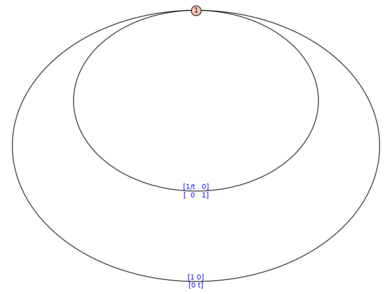
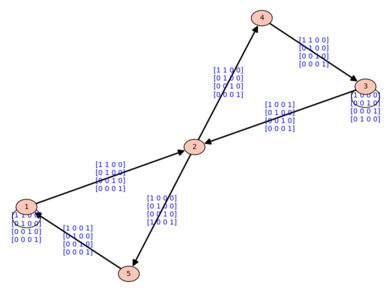
flatsurf Package(s)
people: Charles, Pat, Vincent
Build a nice Sage module for all translation surface related stuff. The aim is to
- merge four distinct projects
Pat and Vincent sage-flatsurf
Vincent flatsurf
Charles code about Lyapunov exponents trac ticket #16102
- add more stuff
- Teichmueller flow for genus 1 quadratic differentials with Riemann theta functions
- More for infinite translation surfaces
- Thurston-Veech construction
visualize Teichmueller spaces
people: Maxime, Kasra
- geodesics, balls, triangles, ... Needs computing Teichmueller maps, i.e. solving PDE
- nice 3d plots to make animations of geodesic in Teichmueller space
A nice animation of a Teichmueller geodesic embedded in R3 (four time punctured sphere):
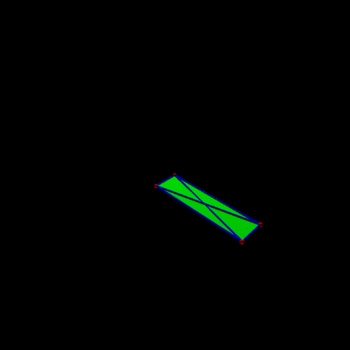
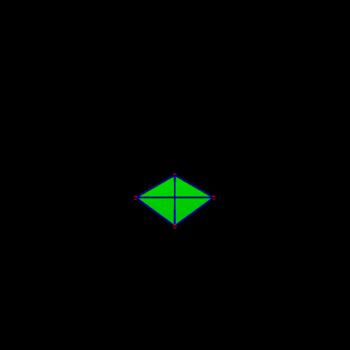
Some graphs
visualize the translation structure induced by a not so nice differential
people: Anja
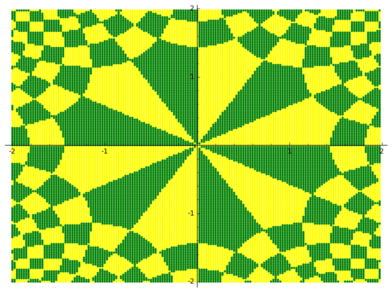
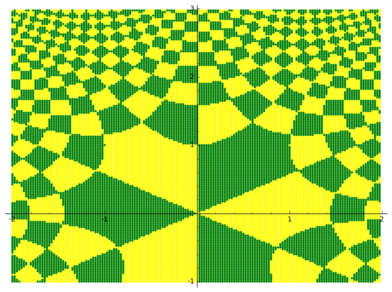
Generating saddle connections in a given surface and study their statistics *efficiently*
people: Grace
Distribution of gap of saddle connection for a surface defined on a cubic field!
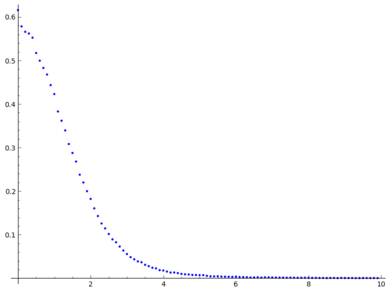
Computing quadratic differentials on tori
people: Charles
Using Weirstrass function one can find explicit formulas for quadratic differentials on tori1: CHARLES PICTURES TO COME!
other projects
- Compute properties of Coxeter or Artin groups (normal forms, ...)
- Incidence relations for vector space over Z/2Z (done!)
- Subgroups of SL(2,R) given from generators. Design an algorithm that given a finite set of matrices in SL(2,R) answers whether the group generated by these is
- not discrete
- has finite covolume
- has infinite covolume
- Affine interval exchange transformations: rotation number for affine circle homeos, generalized Rauzy induction, hyperbolicity, periodic points, ... (Charles)
Existing programs about translation surfaces
- Alex Eskin code (saddle connection exploration + decomposition in cylinders)
various programs by Ronen Mukamel (Delaunay triangulations, Teichmueller curves especially in genus 2)
Vincent Delecroix flatsurf package (mostly interval exchanges and square tiled surfaces, but a bit of topology)
Vincent Delecroix and Pat Hooper drawing program
Charles Fougeron code for Lyapunov exponents of strata coverings (see trac ticket #16102)
Chris Swierczewski Riemann surfaces package
Organizers
Participants
Thierry Monteil (might attend remotely)
Chris Swierczewski (might attend remotely)
Support
This workshop is supported by the ERC H2020 project OpenDreamKit and Punto Mexico Conectado @ Oaxaca.
